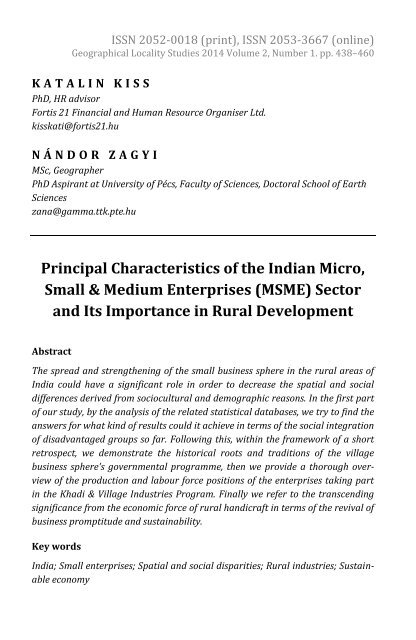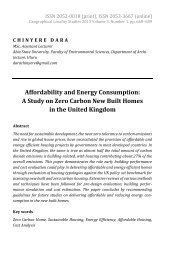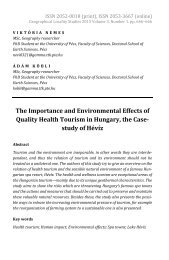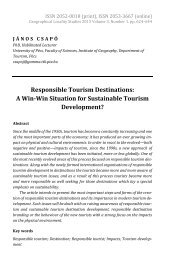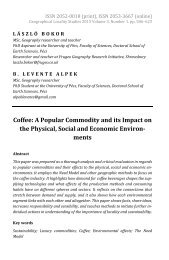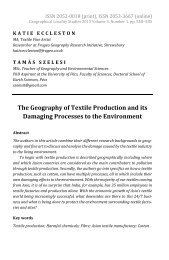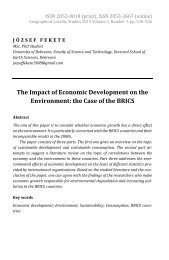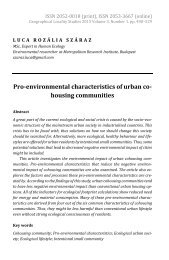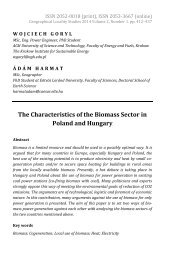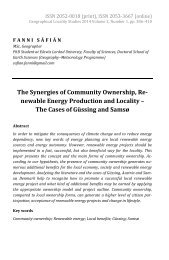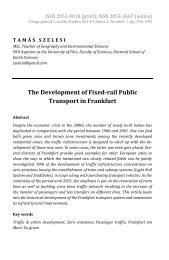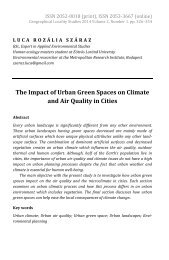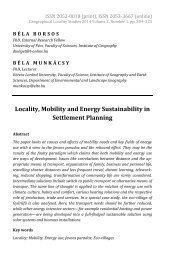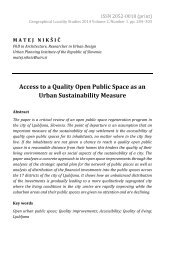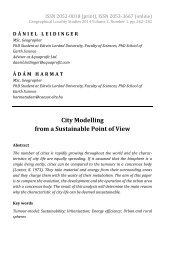Katalin Kiss & Nándor Zagyi: Principal Characteristics of the Indian Micro, Small and Medium Enterprises (MSME) Sector and its Importance in Rural Development
The spread of the small business sphere in the rural areas of India could have a significant role in order to decrease the spatial and social differences derived from sociocultural and demographic reasons. The authors provide a thorough overview of the production and labour force positions of the enterprises taking part in the Khadi & Village Industries Program.
The spread of the small business sphere in the rural areas of India could have a significant role in order to decrease the spatial and social differences derived from sociocultural and demographic reasons. The authors provide a thorough overview of the production and labour force positions of the enterprises taking part in the Khadi & Village Industries Program.
Create successful ePaper yourself
Turn your PDF publications into a flip-book with our unique Google optimized e-Paper software.
KATALIN KISS<br />
PhD, HR advisor<br />
Fortis 21 F<strong>in</strong>ancial <strong>and</strong> Human Resource Organiser Ltd.<br />
kisskati@fortis21.hu<br />
<br />
NÁNDOR ZAGYI<br />
MSc, Geographer<br />
PhD Aspirant at University <strong>of</strong> Pécs, Faculty <strong>of</strong> Sciences, Doctoral School <strong>of</strong> Earth<br />
Sciences<br />
zana@gamma.ttk.pte.hu<br />
<br />
<strong>Pr<strong>in</strong>cipal</strong> <strong>Characteristics</strong> <strong>of</strong> <strong>the</strong> <strong>Indian</strong> <strong>Micro</strong>,<br />
<strong>Small</strong> & Medium <strong>Enterprises</strong> (<strong>MSME</strong>) <strong>Sector</strong><br />
<strong>and</strong> Its <strong>Importance</strong> <strong>in</strong> <strong>Rural</strong> <strong>Development</strong><br />
Abstract<br />
The spread <strong>and</strong> streng<strong>the</strong>n<strong>in</strong>g <strong>of</strong> <strong>the</strong> small bus<strong>in</strong>ess sphere <strong>in</strong> <strong>the</strong> rural areas <strong>of</strong><br />
India could have a significant role <strong>in</strong> order to decrease <strong>the</strong> spatial <strong>and</strong> social<br />
differences derived from sociocultural <strong>and</strong> demographic reasons. In <strong>the</strong> first part<br />
<strong>of</strong> our study, by <strong>the</strong> analysis <strong>of</strong> <strong>the</strong> related statistical databases, we try to f<strong>in</strong>d <strong>the</strong><br />
answers for what k<strong>in</strong>d <strong>of</strong> results could it achieve <strong>in</strong> terms <strong>of</strong> <strong>the</strong> social <strong>in</strong>tegration<br />
<strong>of</strong> disadvantaged groups so far. Follow<strong>in</strong>g this, with<strong>in</strong> <strong>the</strong> framework <strong>of</strong> a short<br />
retrospect, we demonstrate <strong>the</strong> historical roots <strong>and</strong> traditions <strong>of</strong> <strong>the</strong> village<br />
bus<strong>in</strong>ess sphere’s governmental programme, <strong>the</strong>n we provide a thorough overview<br />
<strong>of</strong> <strong>the</strong> production <strong>and</strong> labour force positions <strong>of</strong> <strong>the</strong> enterprises tak<strong>in</strong>g part<br />
<strong>in</strong> <strong>the</strong> Khadi & Village Industries Program. F<strong>in</strong>ally we refer to <strong>the</strong> transcend<strong>in</strong>g<br />
significance from <strong>the</strong> economic force <strong>of</strong> rural h<strong>and</strong>icraft <strong>in</strong> terms <strong>of</strong> <strong>the</strong> revival <strong>of</strong><br />
bus<strong>in</strong>ess promptitude <strong>and</strong> susta<strong>in</strong>ability.<br />
Key words<br />
India; <strong>Small</strong> enterprises; Spatial <strong>and</strong> social disparities; <strong>Rural</strong> <strong>in</strong>dustries; Susta<strong>in</strong>able<br />
economy
1. Introduction<br />
<br />
<br />
<br />
<br />
<br />
<br />
<br />
<br />
<br />
<br />
<br />
<br />
<br />
<br />
<br />
<br />
<br />
<br />
Figure 1 – Change <strong>of</strong> population <strong>in</strong> India <strong>in</strong> <strong>the</strong> last fifty years<br />
Sources: CENSUS ONLINE 2001, 2011a
(Figure 1)<br />
<br />
(Table 1)<br />
<br />
<br />
<br />
(Table 2)<br />
<br />
<br />
<br />
<br />
<br />
<br />
Table 1 – Decadal growth <strong>of</strong> population <strong>in</strong> India<br />
Sources: CENSUS ONLINE 2001, 2011a<br />
Census decades Decadal growth Decadal growth (%)<br />
<br />
<br />
<br />
<br />
<br />
Table 2 – Unemployment rates <strong>of</strong> different age groups <strong>in</strong> India (per 1000)<br />
Source: MLE ONLINE 2013<br />
Age Groups Males & Females Males Females
et al.<br />
et al.<br />
<br />
<br />
<br />
<br />
<br />
<br />
<br />
<br />
<br />
<br />
<br />
<br />
<br />
<br />
<br />
<br />
(Table 3)<br />
Table 3 – <strong>Indian</strong> cities hav<strong>in</strong>g more than one third rate <strong>of</strong> slum population<br />
Sources: CENSUS ONLINE 2011a, 2011b<br />
City (M. Corp.) State Population Slum Rate <strong>of</strong> Slum Pop.
2. Research Method
3. The major structural characteristics <strong>of</strong> <strong>the</strong> <strong>MSME</strong> sector <strong>in</strong> India<br />
<br />
<br />
<br />
<br />
<br />
<br />
<br />
<br />
<br />
<br />
(Table 4)<br />
<br />
Table 4 – Classification <strong>of</strong> <strong>Indian</strong> <strong>MSME</strong>s by quantity <strong>of</strong> <strong>in</strong>vestments<br />
Source: GAZETTE ONLINE, 2006<br />
Category <strong>of</strong> size
(Table 5)<br />
<br />
Table 5 – Change <strong>of</strong> <strong>the</strong> ma<strong>in</strong> quantitative <strong>in</strong>dicators <strong>of</strong> <strong>Indian</strong> <strong>MSME</strong> sector<br />
Source: <strong>MSME</strong> ONLINE 2013<br />
Indicators <strong>of</strong> <strong>MSME</strong>s 2006–2007 2011–2012 Rate <strong>of</strong> growth<br />
<br />
<br />
<br />
<br />
Table 6 – Rate <strong>of</strong> enterprise size categories by <strong>the</strong> ma<strong>in</strong> quantitative <strong>in</strong>dicators<br />
Source: <strong>MSME</strong> CENSUS ONLINE 2011<br />
Indicators <strong>of</strong> <strong>MSME</strong>s Rate <strong>of</strong> micro Rate <strong>of</strong> small Rate <strong>of</strong> medium<br />
<br />
<br />
<br />
<br />
<br />
<br />
<br />
<br />
<br />
<br />
<br />
<br />
<br />
(Table 6)<br />
<br />
<br />
<br />
[Figure 2]<br />
[Figure 3]
Figure 2 – State-wise disparity <strong>in</strong> density <strong>of</strong> work<strong>in</strong>g registered <strong>MSME</strong>s<br />
(Number <strong>of</strong> <strong>MSME</strong>s per 100 thous<strong>and</strong> <strong>in</strong>habitants)<br />
Key: 1: < 50; 2: 50–99; 3: 100–149; 4: 150–200; 5: > 200<br />
Sources: <strong>MSME</strong> CENSUS ONLINE 2011, CENSUS ONLINE 2011a
Figure 3 – State-wise disparity <strong>in</strong> value <strong>of</strong> gross output per <strong>MSME</strong> un<strong>its</strong><br />
(million INR)<br />
Key: 1: < 5; 2: 5–9.9; 3: 10–14.9; 4: 15–24.9; 5: > 25<br />
Source: <strong>MSME</strong> CENSUS ONLINE 2011
(Table 7)<br />
<br />
Table 7 – Gender composition <strong>of</strong> <strong>MSME</strong> owners <strong>and</strong> employees compared<br />
with work participation rate among ma<strong>in</strong> workers<br />
Sources: CENSUS ONLINE 2011a; <strong>MSME</strong> CENSUS ONLINE 2011<br />
<br />
<br />
<br />
<br />
<br />
<br />
<br />
<br />
<br />
<br />
<br />
(Table 8)<br />
<br />
Table 8 – SC- <strong>and</strong> ST-wise composition <strong>of</strong> <strong>MSME</strong> owners <strong>and</strong> employees<br />
compared with share <strong>in</strong> total population<br />
Source: CENSUS ONLINE 2011a; <strong>MSME</strong> CENSUS ONLINE 2011<br />
<br />
<br />
<br />
<br />
<br />
<br />
<br />
<br />
<br />
<br />
<br />
<br />
<br />
<br />
<br />
<br />
<br />
<br />
<br />
(Table 9)
Table 9 – <strong>Rural</strong>-urban composition <strong>of</strong> <strong>MSME</strong> owners, employees <strong>and</strong> ma<strong>in</strong><br />
workers by <strong>the</strong> ma<strong>in</strong> disadvantageous social groups<br />
Source: CENSUS ONLINE 2011a; <strong>MSME</strong> CENSUS ONLINE 2011<br />
<br />
<br />
<br />
<br />
<br />
<br />
<br />
<br />
<br />
<br />
<br />
<br />
<br />
<br />
<br />
<br />
<br />
(Table 10)<br />
Table 10 – Distribution <strong>of</strong> <strong>MSME</strong> owners <strong>and</strong> <strong>the</strong> total population by <strong>the</strong><br />
ma<strong>in</strong> religious communities<br />
Source: CENSUS ONLINE 2001; <strong>MSME</strong> CENSUS ONLINE 2011
4. The Khadi <strong>and</strong> Village Industries Programme (KVIP)<br />
<br />
<br />
<br />
<br />
<br />
<br />
<br />
<br />
<br />
<br />
<br />
<br />
<br />
<br />
<br />
swadeshi <br />
<br />
<br />
<br />
WesternEastern Bengal British India<br />
<br />
et al.
Sri Aurob<strong>in</strong>do<br />
Aurob<strong>in</strong>do Ghose<br />
<br />
B<strong>and</strong>e Mataram<br />
<br />
<br />
<br />
<br />
<br />
<br />
<br />
<br />
<br />
<br />
<br />
<br />
<br />
khadi<br />
<br />
<br />
<br />
<br />
<br />
<br />
<br />
(Figure 4)
charkha<br />
National Congress<br />
<br />
<br />
Figure 4 – G<strong>and</strong>hi sp<strong>in</strong>n<strong>in</strong>g on charkha (unknown location, late 1920s)<br />
Source: ONEFINALBLOG ONLINE (2013)<br />
<br />
G<strong>and</strong>hi<br />
<br />
Rajendra Prasad <br />
<br />
<br />
<br />
<br />
Village Industries Commission Act<br />
Khadi <strong>and</strong> Village Industries Commission
Khadi Programme <br />
<br />
Village Industries Programme<br />
<br />
<br />
<br />
<br />
<br />
<br />
<br />
<br />
<br />
<br />
<br />
<br />
Central Government <br />
<br />
<br />
<br />
<br />
<br />
<br />
<br />
<br />
<br />
<br />
<br />
<br />
<br />
<br />
<br />
<br />
Khadi Programme(Table 11–12)
Table 11 – Relative importance <strong>of</strong> KVI subgroups by sales <strong>of</strong> products<br />
Source: ANNUAL REPORTS ONLINE 2003–2013<br />
<br />
<br />
<br />
<br />
<br />
<br />
<br />
<br />
<br />
<br />
<br />
<br />
<br />
<br />
<br />
<br />
Table 12 – Relative importance <strong>of</strong> KVI subgroups by number <strong>of</strong> employees<br />
Source: ANNUAL REPORTS ONLINE 2003–2013
(Table<br />
13)<br />
Table 13 – Performance <strong>in</strong> sales by KVI subgroups<br />
Source: ANNUAL REPORTS ONLINE 2003–2013<br />
<br />
<br />
<br />
<br />
<br />
<br />
<br />
<br />
<br />
<br />
<br />
<br />
<br />
<br />
Plann<strong>in</strong>g Committee
(Figure 5)
Figure 5 – Conventional <strong>and</strong> modified e-charkha<br />
Source: FLEXITRON ONLINE (n.a.)<br />
<br />
5. Summary<br />
India
References<br />
India története<br />
<br />
Társadalom és politika a gyarmati Indiában (1905–1947).<br />
<br />
Aurob<strong>in</strong>do, SriEncyclopedia <strong>of</strong> India.<br />
<br />
An Autobiography or The Story <strong>of</strong> My Experiments with<br />
Truth<br />
Historical <strong>and</strong> Cultural Dictionary <strong>of</strong> India<br />
<br />
Prasad, Rajendra<br />
<br />
"A Symbol <strong>of</strong> Freedom": The <strong>Indian</strong> Flag <strong>and</strong> <strong>the</strong> Transformations<br />
<strong>of</strong> Nationalism, 1906–2002<br />
<br />
<strong>Small</strong> is Beautiful: A Study <strong>of</strong> Economics as if People<br />
Mattered
Alternative Economics: Economics <strong>of</strong> Mahatma G<strong>and</strong>hi &<br />
Globalisation<br />
<br />
Területi különbségek vizsgálata Indiában / The Survey <strong>of</strong><br />
Spatial Disparities <strong>in</strong> India<br />
<br />
The Survey <strong>of</strong> Spatial Disparity <strong>in</strong> India with <strong>the</strong> Application<br />
<strong>of</strong> <strong>the</strong> SENTIENT Index –<br />
<br />
The Survey <strong>of</strong> Spatial Disparity<br />
<strong>in</strong> India with <strong>the</strong> Application <strong>of</strong> <strong>the</strong> SENTIENT Index with Special Focus on<br />
Religious Composition.<br />
<br />
<br />
Electronic sources<br />
Annual Reports <strong>of</strong> <strong>MSME</strong>s<br />
<br />
<br />
How India Wrought for Freedom: The Story <strong>of</strong> <strong>the</strong> National<br />
Congress Told from Official Records<br />
<br />
<br />
<br />
Tabulations Plan <strong>of</strong> Census Year 2001<br />
<br />
<br />
<br />
Population Enumeration Data (F<strong>in</strong>al Population)<br />
<br />
<br />
<br />
<br />
Provisional Population Totals Paper 2 <strong>of</strong> 2011: India (Vol<br />
II)(pdf)
India<br />
<br />
<br />
Globalization & Its Impact <strong>in</strong> <strong>Small</strong> Scale Industries<br />
(pdf)<br />
<br />
<br />
-charkha: The Humble G<strong>and</strong>hi Charkha is now e-<br />
charkha<br />
<br />
<br />
Constructive Programme: Its Mean<strong>in</strong>g <strong>and</strong> Place<br />
<br />
<br />
<br />
<br />
(pdf) <br />
<br />
<br />
The Flag <strong>of</strong> India<br />
<br />
<br />
<br />
Az önellátás filozófiája<br />
<br />
<br />
<br />
Khadi: Release <strong>of</strong> e-Charkha(pdf)<br />
<br />
<br />
<strong>Small</strong> Scale Industries: Striv<strong>in</strong>g <strong>and</strong> Thriv<strong>in</strong>g <strong>in</strong> <strong>the</strong> Era <strong>of</strong><br />
Globalization(pdf)<br />
<br />
<br />
Report on Third Annual Employment <strong>and</strong> Unemployment<br />
Survey (2012- 2013) Volume 1(pdf)
Annual Report 2012–2013: <strong>Micro</strong>, <strong>Small</strong> & Medium <strong>Enterprises</strong>(pdf)<br />
<br />
<br />
<br />
Fourth All India Census <strong>of</strong> <strong>Micro</strong>, <strong>Small</strong> & Medium<br />
<strong>Enterprises</strong> 2006–2007(pdf)<br />
<br />
<br />
<br />
M<strong>and</strong>ela. Yes. MLK. Yes. G<strong>and</strong>hi. No<br />
<br />
<br />
<br />
Evaluation Study on Khadi <strong>and</strong> Village<br />
Industries Programme(pdf)<br />
<br />
<br />
<br />
A Macroeconomic Analysis <strong>of</strong> <strong>the</strong> <strong>Indian</strong> Economy


